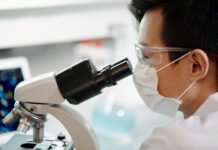Sustainable sources of energy like wind and solar are attractive options for a greener future, but they are also intermittent, fluctuating with conditions like weather and time. That creates a pressing need to find ways to store that energy during peak production for future use.
An ideal solution would need to be cost effective and use common materials.
A new catalyst made of common metals can use sustainable electricity to split water molecules in seawater to form hydrogen. The resulting hydrogen could be used directly in fuel cells or as a feedstock for many other chemicals, including hydrocarbon fuels.
The catalyst, developed in the Sargent Group at the University of Toronto, was published in Nature Energy.
Currently, the best catalysts are based on platinum, an expensive and rare element that works best in acid. That’s because acids already have a high concentration of protons (hydrogen ions) available to react with the ones newly formed by splitting water, thus forming hydrogen gas.
By contrast, the new catalyst is based on more inexpensive and abundant copper, nickel and chromium. While less efficient than platinum catalysis, the amount of electrical energy required for hydrogen production is the lowest recorded for any catalyst in pH-neutral water.
The key to the new catalyst is its ability to hold released protons, because these are so much more scarce in neutral water. The catalyst is built on a copper foam structure for increased surface area. Copper (II) oxide nanowires are grown on that foundation, and nickel–copper mixture and chromium oxide are then deposited over the entire structure.
The nickel grabs onto a water molecule’s hydrogen group, and the chromium oxide sites bind the remaining hydroxyl group. These opposing forces facilitate the breakdown of the water molecule.
The nickel-copper mixture features just the right balance of affinity for protons to hold them close but release them for coupling.
Notably, the new catalyst also works in saltwater. This means that ordinary seawater can be used instead of precious freshwater, all without the added cost of desalination.
At the same time, a pH-neutral environment makes it possible to grow cells in the same reactor. Microorganisms could immediately use the liberated hydrogen as a food source, combining it with CO2 from carbon capture processes to convert both into hydrocarbon fuels like ethanol or methanol.
Beyond energy storage, hydrogen is also an important feedstock in manufacturing chemicals, like the ammonia that goes into fertilizers. Currently, most hydrogen is made from fossil fuels, meaning they have a large carbon footprint.
The clever design of this multi-stage catalyst opens many opportunities to reduce fossil fuel use while maintaining stable power around the clock.









































